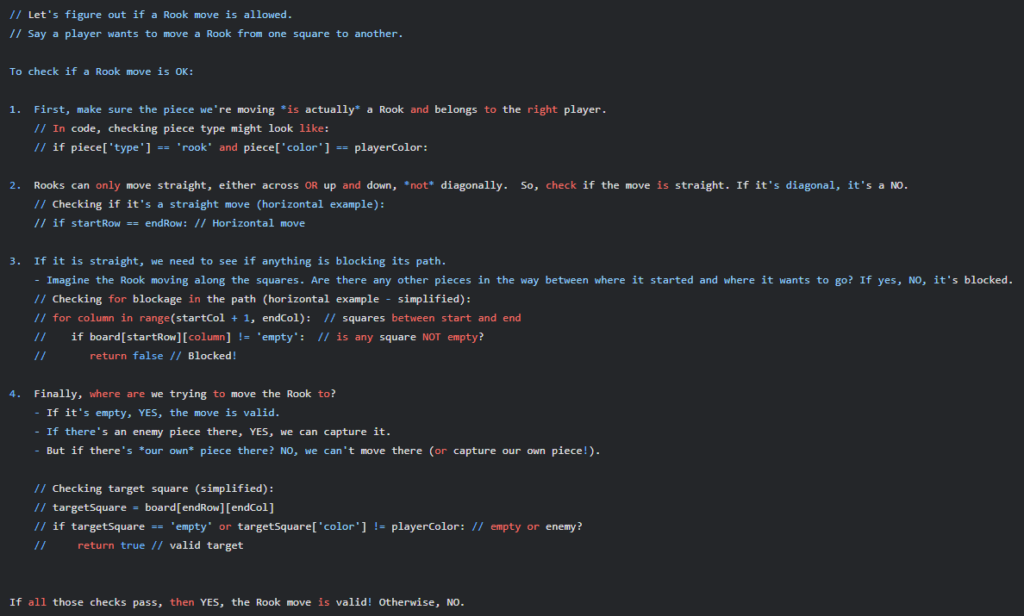Want to test your coding skills in a way that’s both challenging and super rewarding? Coding a chess game is a fantastic project for beginners and even seasoned programmers!
Chess is a classic strategy game loved by millions of people worldwide – it’s crazy how a “simple” game can be this deep and challenging. And guess what? Turning that complexity into code is a really cool journey.
So, you’re wondering how to code a chess game yourself? This guide will take you through the steps to code a basic, working chess game. Don’t worry, we’ll (try to) keep it beginner-friendly!
How to code a chess game: setting up your coding environment
Before we jump into the chess logic itself, let’s quickly set up your coding environment – it’s simpler than you might think.
First, you’ll need to pick a programming language. For beginners, Python (PyGame), C# (Unity), JavaScript (web-based game engines) are excellent choices. They’re known for being easier to learn and read, which is perfect for this project.
Python is often recommended for beginners because of its clear syntax, C# for being widely used in game development, and JavaScript is great for making a web-based game later on. Honestly, though, the core logic can be adapted to almost any language later.

Next, you’ll need a text editor or an IDE (Integrated Development Environment). For simple projects like this, a basic text editor like VS Code, Sublime Text, or even just Notepad (if you’re feeling old-school!) will work just fine. IDEs like PyCharm or IntelliJ IDEA are more powerful but might be overkill for this initial project, especially if you’re just starting out. The important thing is to have a place to write and save your code.
Finally, as for libraries or frameworks, let’s keep things basic for a moment. You can absolutely use them to make things fancier later, but we’ll focus on the fundamental logic using just the built-in functionalities of your chosen language. Keep it simple to start – you can always add bells and whistles later!
Coding a chess game’s core components
To learn how to code a chess game effectively, you’ll need to think about the essential parts that make chess, well, chess. Let’s break down the key components you’ll need to code:
Representing the board
How do you show a chessboard in code? The most common way is to use a 2D array (also sometimes called a grid or a matrix) with 8 columns and rows. Each cell in this grid will represent a square on the chessboard. You can use numbers or letters to label rows and columns if you like, but fundamentally it’s a grid.
Representing pieces
You need a way to represent each piece – pawn, knight, bishop, rook, queen, and king – and also keep track of whether it’s black or white. You can do this using objects or classes (if your language supports them), or even simpler data structures like dictionaries or tuples.
Each piece will need attributes like its type (pawn, rook, etc.), its color (black or white), and its current position on the board (using those grid coordinates we just talked about).
Valid moves logic
You also need to code the rules for how each piece moves. This is the heart of your chess game logic. Think about it: pawns move differently than rooks, knights have that L-shape move, bishops move diagonally, and so on.
You’ll need to write code that checks if a move a player wants to make is actually valid according to chess rules for that piece and its current position. Fun fact: this is probably the most complex part of a text-based chess game.
See the example below for checking valid moves for a rook:

Game state management
The code needs to keep track of the game state. Whose turn is it? Which pieces have been captured? Who is ahead? Is the king in check? Is it a checkmate? You’ll need variables to store this information and update them as the game progresses. Keeping track of whose turn it is, for example, is a must for turn-based gameplay.
Input and output
How will the player interact with your game? For a basic text-based chess game (which is a great place to start!), you’ll use text input for players to enter their moves. Then you’ll also use text output to display the chessboard in the console.
If you get fancier later and add a graphical interface, you’ll need to handle mouse clicks or touch inputs, but for now text input and output are perfect for getting the core game logic working.
Improving your chess game (optional next steps)
Once you’ve got a basic and text-based chess game working, congrats! That’s a real accomplishment. But, if you’re feeling ambitious and want to push your project further, there’s a whole chessboard of possibilities to explore for enhancements. Think of these as optional “side quests” to level up your game and your coding skills.
- UI polish: even without a full GUI, you can enhance the text interface. Make the board display clearer (Unicode pieces, color coding!). Improve the move input to be more user-friendly. Add helpful error messages, an “undo” move feature, or a move history display. Even small tweaks can bring massive bonuses to usability;
- Graphical User Interface (GUI): text chess is cool, but visual chess is cooler, right? Moving to a GUI is a game-changer. Picture a proper chessboard on screen, with drag-and-drop pieces. Use libraries like Pygame (Python) or HTML5 Canvas (JavaScript) to display your board, design piece images (or grab some free assets online!), and let players interact with mouse clicks. A GUI will transform your game’s look and feel while also making it more approachable;
- PGN game saving/loading: let players save and share games! Implement PGN (Portable Game Notation), the standard format for chess games. This lets players save games to files, load saved games, and even share games online. Libraries exist to help you read and write PGN data easily;
- AI opponent: do you want to play on your own? Add an AI! Start simple – a basic AI that picks random valid moves. For a real challenge, implement the Minimax algorithm or even integrate a powerful chess engine like Stockfish (it’s open source!). Different AI difficulty levels could make your game appealing to everyone, from beginners to chess pros.
These enhancements can take your chess game from a basic project to something genuinely impressive. Pick what excites you and keep building!

Coding a chess game is easier with professional guidance!
And this was our basic guide on how to code a chess game! Despite having gone in some detail about potential improvements, there’s a whole world of features you can add to make it more polished, more user-friendly, and more challenging.
In any case, the key is to start simple, get the core functionality working, and then gradually add more complexity as you go. Game development is all about building step by step, experimenting, and having fun with the process. And who knows? With enough dedication, you might just create a chess game that rivals the classics!
If all this talk about game development has got you excited about creating games of all kinds, Main Leaf is here to help. We’re a team of talented and experienced game developers ready to bring your game visions to life.
Whether you’re dreaming of a mobile puzzle game, a sprawling RPG, or anything in between, we have the expertise to make it happen. Got a game idea in mind? Reach out to our studio today, and let’s discuss how we can turn your wildest dreams into a reality!

